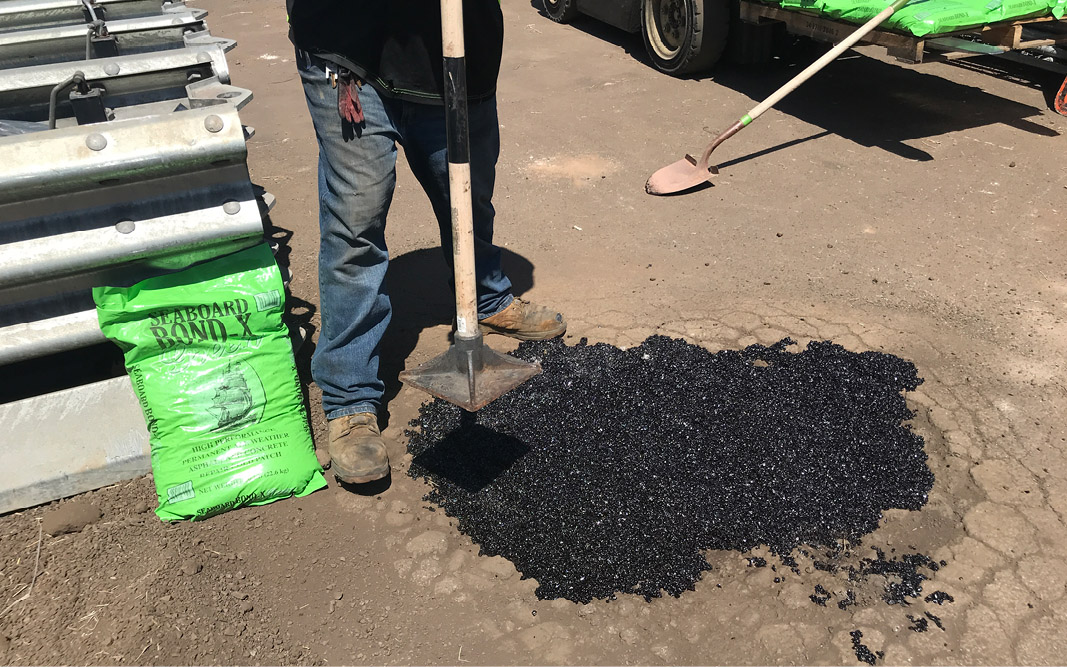By Brad Tom
We have been paving roads in the US since the late 1800s and we have had deal with repairing potholes in them ever since. Repairing a hole in asphalt is not difficult but making sure it stays repaired for years can take a bit of planning. Because Hawaii has hot humid weather that can often include rain almost daily in some parts of the island, repairing asphalt is critical. Since we are owned by a local paving company in Hawaii, we found it important to advise local home owners how to care for your property. We will go over the basics of asphalt pothole repair but as with anything, read labels for all products to ensure your products are applied correctly.
Why Is There a Pothole?
Potholes form when enough asphalt material gets dislodged from your pavement to form a hole. It usually starts off as an alligator crack (series of interconnected surface cracks) in the pavement. Once water gets between the aggregate that is “glued” together by asphalt, you will start to lose material and cracks develop. Eventually vehicle traffic will loosen and dislodge chunks of pavement and result in a pothole. If water gets into the subbase, you risk the integrity of the foundation that your asphalt is built upon. Therefore, it is critically important to ensure your asphalt pavement is repelling water to keep it intact. Routine sealcoating will help maintain waterproof integrity of your asphalt. A well maintained asphalt drive way may last beyond 30 years.
What is the Best Asphalt Patch and Pothole Filler for My Driveway?
Unless you have access to asphalt road paving equipment you have to rule out hot mix asphalt (what roads are created with). There are many brands of asphalt patching material called “Cold Patch” out there. Cold pothole patch has been around for many years. Traditional cold patch is aggregate mixed with an oil bitumen-like binder that hardens over time like hot mix asphalt. Hot asphalt oils start to harden when its temperature cools down from around 185°F. Cold patch on the other hand cures over time. Most municipalities use it for quick pothole fixes because it is cheap and easy to install. Installing properly is one of the keys to making sure this doesn’t turn into a recurring job whenever it rains.

A Greener Way to Patch Asphalt
Traditional cold patch asphalt will include petroleum-based solvents such as diesel, toluene, kerosene and naphthalene. Because of the harmful chemicals of these older cold patch mixes it can produce volatile organic compounds (VOCs) that will affect the air for consumers and workers installing it. A new product by Seaboard called Bond-X Green doesn’t utilize these harmful chemicals as binders.
Bond-X Green High-Performance Cold Patch is a high quality, pre-mixed, all weather, permanent asphalt “cold patch” compound. Combining a carefully selected aggregate with a special bitumen formula using a biodegradable, renewable, organic solution to replace petroleum derivatives normally found in conventional cold mix asphalt.
Using Bond-X Green is considered an Environmentally Preference Purchase. This product and your distributor meet the EPP product purchasing guidelines. Seaboard Asphalt is a member of the National Asphalt Paving Association. Bond-X Green is approved for use where low VOC requirements are in place.
Benefits of Bond-X Green Over Water Activated Cold Patch
Other water activated cold patch mixes use rapeseed oil in their bitumen formula. Rapeseed oil is toxic to humans because it contains appreciable amounts of toxic erucic acid.
Homeowners Asphalt Pothole Repair Instructions
Prepare hole to be filled. Clear away all loose rock and debris from the area to be patched. Make sure the patch has solid sides that it can adhere to. Remove any crumbling sides to ensure the patchwill stay in place. If the hole is deep, your patch should be applied in 2” layers. If the pothole goes farther down than the original asphalt layer, you may have to fill the hole with rock or dirt and tamp down to ensure a solid foundation to place your patch upon.
Fill with patch mix. For cold mix, follow bag instructions. You should just be able to fill hole directly with mix from bag. If it is a large hole, fill in sections at a time in 2” layers, tamping down to compact the mix. For other rapid curing patch mixes you may need to mix with water or other liquid before filling. Follow container instructions carefully, as water mixed patch formula may be toxic.
With all mixes, fill so that you have a peak in the middle of the hole that is about 1” or for larger holes 2” above the level of the surrounding asphalt. This will allow for spreading during compaction. Compact the mix with a pothole tamper to begin pounding out the asphalt aggregate to flatten it out. Driving over the hole with a vehicle will help the compaction if you do not have a vibrating plate compactor. The better you can compact the mix before it completely cured, the better chances of the patch lasting.
If you have questions about pothole patching or any other asphalt maintenance items visit our site or contact us and we will be happy to walk you through the process.
